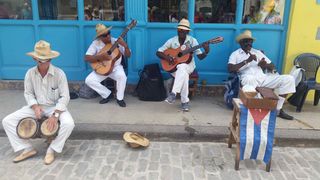
When was the last time you sat down to a breakfast and were served a platter of sliced mango, guayaba, pineapple, banana and watermelon? How about eggs as you like them with sautéed onions, toast, and café con leche as your second course? That’s desayuno(breakfast) in Cuba. It’s standard, in the fancy hotels as well as the down-home places.
Alternately: Who would think that a taxi ride from one part of the city to another amounts to a not-to-be-missed tourist outing? Nobody describes the New York cab experience this way.
Other cultures feature qualities that complement and potentially correct imbalances that we experience within our own. Increased familiarity between nations helps us negotiate differences. The Middle Ground speaks to an area in-between cultures that allows mutual understandings and compassion to emerge. Comparing and contrasting customs refreshes our outlook on ourselves.
Go to Cuba with your partner or—if single—on your own, prepared not to lose yourself, but to find your earthy spark.
Twenty-first century people seek a refuge from fear and a respite from unnecessary risk. However, avoidant life-strategies leave us adventure-deprived. Approaching unfamiliar settings mindfully expands attitudes. Openness to new experiences and the learning that comes with them serves us well in keeping our outlook—including the way we connect with our partners and friends—vital. This is a prime motivation behind time-off travel. Scene change can lift us.
Here are some prominent features of the island:
The People: They are friendly, warm and engaging. Conversation flows easily—especially if you know some basic Spanish. If not, the will to get an idea or question across is usually sufficient for making connections. Talk with Cubans and you will understand ways in which they feel enriched: universal health care and education are roundly praised and highly prized. And you also will learn that they feel depleted in other respects—Cuban citizens are prohibited from entering many tourist areas unless they are performing a service. They are banned from most hotels and resort areas unless employed there. Inter-city travel around the island is not openly prohibited, but is organized in such a way that inhibits spontaneity. Internet availability is not yet common. The locals I spoke with exude pride in their country and history but if asked about changes they’d like to see, they speak at length.
The Cars: Predominantly American, made in the 1950’s, the autos on the island reflect reverence for U.S. glamour. Convertible Fords, Plymouths and Chevrolets ramble down the road. Their bold curves and fin-styled rear ends parade by in the too-sparse breeze. They will turn your head and prompt you to point your camera. For $35 CUC an hour (approximately $40 US dollars) the swankiest of these can be rented, along with an experienced driver to serve as tour guide. The drive around Havana is as splendid as anEsplendido—Cuba’s honey-dipped, pyramid-tipped, top-tier cigar.
Many physicians, college lecturers, language specialists, and so on, can—and do—increase their income by serving the tourist trade. Our escort throughout the capital was a former veterinarian who increased his income eight-fold by hosting sightseers in his hot pink Ford Fairlane convertible.
Other areas of note and renown:

Music: ubiquitous and magnificent. You see and hear players and singers on many corners, in the plazas and parks, in bars and restaurants and even museums.
Currency: The US dollar gets hammered in conversion. You lose approximately 13% value. Wiser, at this moment, is to bring Canadian dollars to Cuba and convert them to CUC pesos with an approximate 3% conversion rate; you save 10% of your cash.